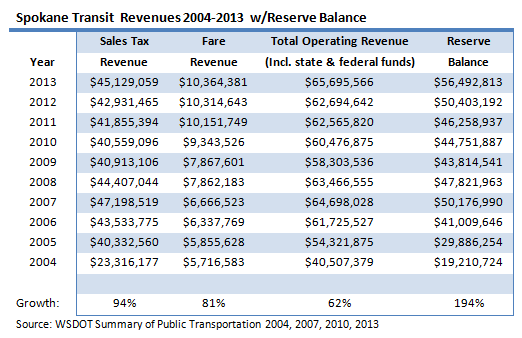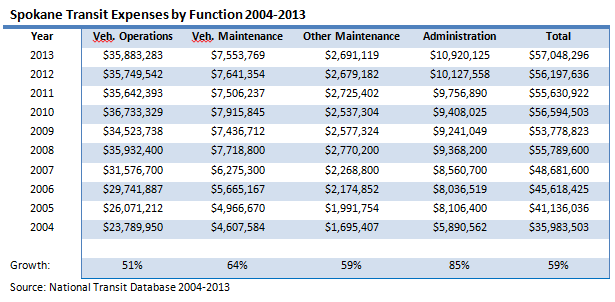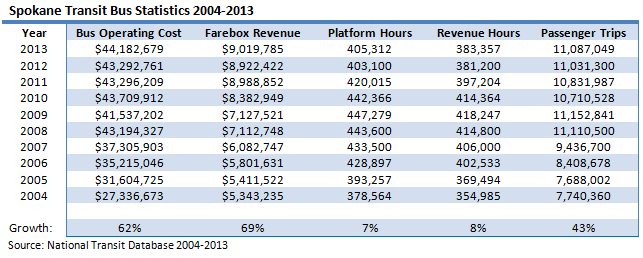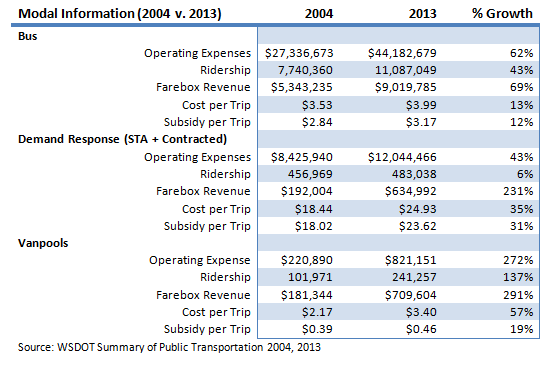Download a PDF of these Key Facts with citations here.
New research released by Washington Policy Center, an independent research organization with offices in Spokane, Olympia, Seattle and Tri-Cities, provides key facts on Spokane Transit Authority (STA). STA operates as a Public Transportation Benefit Authority and serves the cities of Spokane, Cheney, Medical Lake, Millwood, Liberty Lake and Spokane Valley, along with other areas of incorporated Spokane County.
STA provides fixed route bus, demand response, and a vanpool program to residents throughout its 248 square mile service area. STA’s governing body consists of nine elected officials from the service district, and includes one non-voting labor representative.
Board members at the Spokane Transit Authority want to increase the rate of the sales tax they collect by 50 percent, from a rate of 0.6 percent to a 0.9 percent, through a measure that voters will consider on the April 28th ballot. If approved, the measure would enact the highest sales tax STA officials are able to impose under state law. The ballot measure includes money to build a special electric trolley line in downtown Spokane.
STA officials say that unless the higher tax is approved they will reduce bus service in area communities between 20 and 25 percent.
STA’s total operating revenues in 2013 were $65.7 million, with total operating expenses of $57 million. STA’s primary source of revenue comes from a 0.6 percent retail sales tax on goods and services throughout its taxing district. In 2013, sales tax collections represented 70 percent of its total revenue - about $45 million. Revenue from fares equaled $10 million, or about 17 percent of total revenue.
STA ended 2013 with reserves of $56.5 million, the bulk of which was placed in Unrestricted Cash and Investment accounts. Overall, STA’s operations make it one of the state’s best managed public transit agencies. For example, the cost to carry a passenger on an STA bus remains one of the lowest of urban transit agencies in the state at less than $4.00. However, there are concerns about some aspects of STA’s operation.
STA’s bus program, which represents the bulk of STA’s transit system, has enjoyed ridership growth of 43 percent over the past decade. But, partially due to its success in gaining ridership, bus operating expenses have grown 62 percent, a little less than three times the rate of inflation (23 percent). Some of this spending growth can be attributed to increases in bus service. Yet over the 10-year period, transit officials only expanded bus service by seven percent.
STA officials increased their cost of operating an hour of bus service from $77 per revenue hour to $115 per hour, a 50 percent increase over 10 years, commensurate with a 55 percent increase in salaries, wages and benefits over the same time period.
Typical of most transit agencies, STA’s directly-operated paratransit program is its most costly service per passenger. It cost $32.94 to carry one passenger aboard STA’s paratransit bus. Taxpayers provide a subsidy of about 95 percent, or $31.17 per trip. STA officials do, however, contract out some of their paratransit trips to a private operator, at a per trip cost of $16.25, with taxpayers picking up $15.43 per passenger trip.
STA’s vanpool program continues to operate well and serve customer demand. In 2004, vanpool riders paid 82 percent of the cost of the trip. In 2013, users paid about 86 percent. Over the 10-year period, ridership has more than doubled while both revenues and expenses have nearly tripled.
Transit officials have devoted the largest spending growth percentage-wise to administration, with administrative costs growing by 85 percent –between 2004 and 2013 - to $11 million per year.
Thanks to the hard-working people of Spokane County, STA’s sales tax revenue grew 94 percent over the last decade. Money collected from fares grew 81 percent and reserves ballooned 194 percent.
STA’s past performance and future plans
Under state law, public transit officials can ask for up to 0.9 percent sales tax rate in the areas where they operate. In 2004, STA board members proposed Proposition 1, a ballot measure to double the sales tax they impose - from 0.3 percent to 0.6 percent - until 2009 to preserve bus service and to “provide for anticipated future bus and paratransit service needs.” Voters approved the ballot measure.
STA officials received voter approval to make the tax permanent in 2008. Between 2004 and 2008, STA officials increased bus service from 378,000 hours to 443,000 hours, a 17 percent increase, but at a high cost. Operating costs grew 55 percent over the five-year period, mostly attributed to salaries, wages and benefits. While inflation grew only 14 percent, salaries, wages and benefits jumped 41 percent over the period. Ridership grew 43 percent.
However, the ballot measure was promoted to “preserve the region’s public transportation system.” Since voters approved the ballot measure, though, bus service has actually declined, from 443,000 hours of bus service to 405,000 - a 9 percent decrease. Although STA officials have been able to contain cost growth since the recession, it has achieved this partly by cutting and restructuring neighborhood bus service. Since the 2008 vote, ridership has remained flat.
Looking to the future, Spokane Transit Authority officials plan to deplete cash reserves by spending $60 million through 2020 on capital projects, including $22 million for new buses and $17 million in technology upgrades. After cash reserves are depleted, STA officials plan to begin cutting service as early as 2017, unless the April ballot measure passes.
Recommendations
Overall, STA appears to be a relatively well-managed transit agency. Prior to the recession, however, operating costs grew at four times the rate of inflation with only a 17 percent increase in bus service. While STA officials may now have a firmer grip on containing cost growth, new tax revenues and spending too rapidly may place STA on an unsustainable path. In addition, their plans to deplete reserve funds and reduce bus service in Spokane area neighborhoods will fall hardest on the most vulnerable residents in the community. The plan to reduce bus service while spending reserves on capital expansions to enhance bus service may also seem like a paradox to many members of the public.
STA officials should also work to further contract-out paratransit service. Paratransit currently consumes 20 percent of operating expenses, yet it only carries four percent of trips on STA services. Fully contracting out would reap millions of dollars in windfalls for the paratransit program and for the agency generally.
In addition, STA officials should expand the use of vanpools and work toward full cost recovery to make the vanpool program more self-sustaining. STA officials should also control the growth of their administrative costs, as these present a growing part of STA’s budget, directly competing with bus services provided to the public.
Revenues/Expenditures



Modal Statistics






